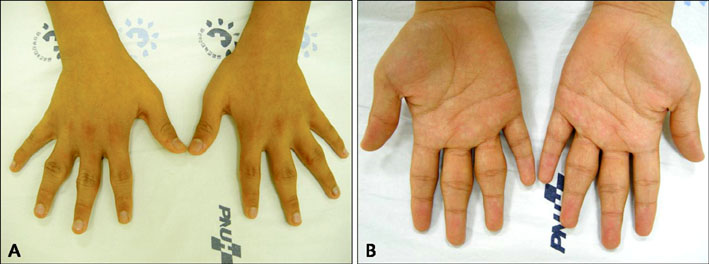Ann Dermatol.
2011 May;23(2):258-261. 10.5021/ad.2011.23.2.258.
A Case of Pachydermodactyly
- Affiliations
-
- 1Department of Dermatology and Medical Research Institute, Pusan National University Hospital, Yangsan, Korea. soesh97@daum.net
- 2Department of Orthopedics, Dong-A University Medical Center, Busan, Korea.
- KMID: 2156678
- DOI: http://doi.org/10.5021/ad.2011.23.2.258
Abstract
- Pachydermodactyly (PDD) is a rare, benign form of digital fibromatosis and this is characterized by asymptomatic soft tissue swelling that affects the lateral aspects of the proximal interphalangeal (PIP) joints of the fingers. Although the etiology of PDD is unknown, the possibility of repetitive minor trauma by habitual or compulsive habits of interlacing the fingers or rubbing of the fingers has been suggested as a cause by several authors. We experienced a 14-year-old boy who was diagnosed as having PDD by the clinical manifestations and this was supported by a radiological study and the routine laboratory tests. He also had the habit of repetitively manipulating his hands when feeling emotional distress. PDD sometimes can be misdiagnosed as a rheumatic condition. Although an unusual disorder, PDD should be considered in the differential diagnosis of patients who present with digital bulbous swelling.
Keyword
Figure
Reference
-
1. Bazex A, Dupré A, Teillard J. Pachydermie digitale des premieres phalanges par hyperplasie conjonctive dermique et aplasie hypodermique. Bull Soc Fr Dermatol Syphiligr. 1973. 80:455–458.2. Beltraminelli H, Itin P. Pachydermodactyly--just a sign of emotional distress. Eur J Dermatol. 2009. 19:5–13.3. Ye S, Chen SL, Dong YQ, Lin F, Guo Q, Bao CD. Pachydermodactyly: six new cases from China. J Clin Rheumatol. 2005. 11:72–75.4. Sola A, Vazquez-Doval J, Sola J, Quintanilla E. Pachydermodactyly transgrediens. Int J Dermatol. 1992. 31:796–797.
Article5. Sandobal C, Kuznietz A, Varizat A, Roverano S, Paira S. Pachydermodactyly: four additional cases. Clin Rheumatol. 2007. 26:962–964.
Article6. Taylor-Gjevre R, Saxena A, El Maadawy S, Classen D, Nair B, Gjevre J. A case of deforming pachydermodactyly. J Clin Rheumatol. 2009. 15:78–80.
Article7. Kang BD, Hong SH, Kim IH, Kim WK, Oh CH. Two cases of pachydermodactyly. Int J Dermatol. 1997. 36:768–772.8. Kim TH, Cho YH, Park HB. Two cases of pachydermodactyly. J Dermatol. 1996. 23:419–424.
Article9. Hagedorn M, Graf HG, Grosshans E. Pachydermodactyly. Sequela of obsessive-compulsive neurosis. Hautarzt. 1994. 45:88–90.10. Dupin N, Gautier MS, Rabary G, Auffret N, Beltzer-Garelly E, Binet O. Pachydermodactyly. Ann Dermatol Venereol. 1994. 121:632–634.11. Meunier L, Pailler C, Barneon G, Meynadier J. Pachydermodactyly or acquired digital fibromatosis. Br J Dermatol. 1994. 131:744–746.
Article12. Park JH, Lee CW. A case of pachydermodactyly treated by surgical excision. Korean J Dermatol. 2006. 44:369–371.



